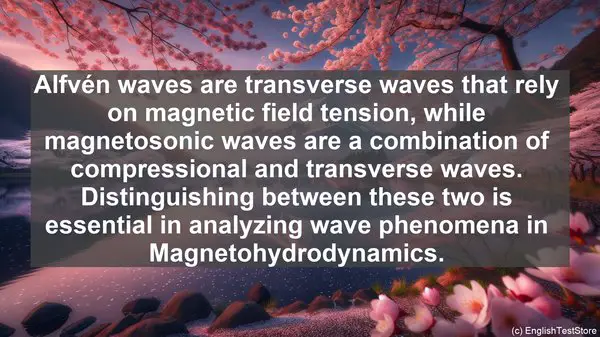Introduction: The Language of Magnetohydrodynamics
Welcome to our lesson on the top 10 commonly confused words in Magnetohydrodynamics. As with any scientific field, Magnetohydrodynamics has its own set of specialized terms. However, some words often lead to confusion due to their similar spellings or meanings. Today, we’ll shed light on these words and clarify their distinctions.

1. Plasma vs. Plasmoid
Plasma and plasmoid are two terms that are often used interchangeably, but they have distinct meanings. Plasma refers to a state of matter consisting of charged particles, while a plasmoid is a coherent structure within a plasma. Understanding this difference is crucial when studying phenomena like magnetic reconnection.

2. Alfvén Wave vs. Magnetosonic Wave
Alfvén waves and magnetosonic waves are both types of waves that propagate in a magnetized plasma. However, their properties and behaviors differ. Alfvén waves are transverse waves that rely on magnetic field tension, while magnetosonic waves are a combination of compressional and transverse waves. Distinguishing between these two is essential in analyzing wave phenomena in Magnetohydrodynamics.
3. Resistivity vs. Conductivity
Resistivity and conductivity are terms that describe the electrical properties of a material. Resistivity refers to a material’s ability to resist the flow of electric current, while conductivity is the measure of its ability to conduct current. In Magnetohydrodynamics, these terms play a crucial role in understanding the behavior of plasmas and magnetic fields.
4. Ionosphere vs. Magnetosphere
The ionosphere and magnetosphere are two regions of Earth’s upper atmosphere. The ionosphere is ionized by solar radiation and is responsible for phenomena like the auroras. On the other hand, the magnetosphere is the region around Earth influenced by its magnetic field. Understanding the distinctions between these two is vital when studying space weather and its impact on our planet.
5. Dynamo Theory vs. Magnetohydrodynamic Turbulence
Dynamo theory and magnetohydrodynamic turbulence are both areas of research in Magnetohydrodynamics. Dynamo theory focuses on the generation and maintenance of magnetic fields in astrophysical bodies, while magnetohydrodynamic turbulence deals with the chaotic behavior of plasmas. While related, these two fields have different objectives and methodologies.
6. Reconnection vs. Dissipation
Reconnection and dissipation are processes that occur in plasmas. Reconnection refers to the rearrangement of magnetic field lines, often leading to energy release and particle acceleration. Dissipation, on the other hand, involves the conversion of magnetic or kinetic energy into heat. Understanding these processes is crucial in various applications, from fusion research to solar flares.
7. Adiabatic vs. Isothermal
Adiabatic and isothermal are terms used to describe thermodynamic processes. An adiabatic process occurs without the exchange of heat with the surroundings, while an isothermal process maintains a constant temperature. In Magnetohydrodynamics, these terms are often used to analyze the behavior of plasmas under different conditions.
8. Hall Effect vs. Pedersen Current
The Hall effect and Pedersen current are both phenomena related to the interaction between a plasma and a magnetic field. The Hall effect refers to the generation of a voltage perpendicular to both the current and the magnetic field, while the Pedersen current is a horizontal current flowing in the ionosphere. Understanding these effects is crucial in various applications, from space weather prediction to magnetospheric dynamics.
9. Magnetopause vs. Bow Shock
The magnetopause and bow shock are two boundaries in the magnetosphere. The magnetopause is the boundary separating the magnetosphere from the solar wind, while the bow shock is the region where the solar wind is slowed down and deflected. These boundaries play a crucial role in shielding Earth from the solar wind’s direct impact.
10. Kelvin-Helmholtz Instability vs. Rayleigh-Taylor Instability
Kelvin-Helmholtz instability and Rayleigh-Taylor instability are both types of fluid instabilities. Kelvin-Helmholtz instability occurs at the interface between two fluids with different velocities, while Rayleigh-Taylor instability occurs when a denser fluid is above a lighter fluid in a gravitational field. These instabilities have implications in various natural phenomena, from cloud formations to astrophysical jets.
